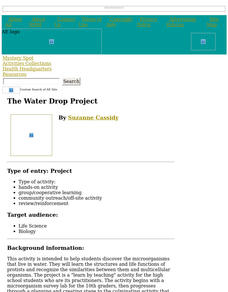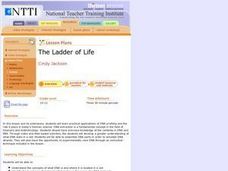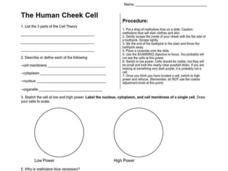Curated OER
Hawaii's Freshwater Ecosystems
Students examine brackish water. In this Science lesson plan, students observe organisms found in brackish water. Students record their observations of the various organisms.
Curated OER
Cell Study
Students (females) are introduced to the cell. They discuss what a cell is, and students define what a cell is. Students comprehend that all living things are made up of cells. They comprehend that life is defined as something that...
Curated OER
Life Cycle: Diversity in a Balance
In this life cycle workbook, 3rd graders complete several different activities in which they analyze different invertebrates, identify arthropods, examine human biology and plants, and study natural environments. 20 different activities...
Curated OER
The Water Drop Project
Students discover the microorganisms that live in water. They study the structures and life functions of protists and recognize the similarities between them and multicellular organisms.
Curated OER
Dissolved Oxygen in an Aquatic Ecosystem
High schoolers explain why dissolved oxygen is important in aquatic ecosystems. They evaluate the optimal dissolved oxygen levels for living organisms.
Curated OER
Creating Coacervates
Students create and observe coacervates. For this origin of life lesson, students create coacervates by mixing carbohydrate and protein solutions. They observe the life-like qualities of the structures and discuss the origin of life.
Curated OER
Diatoms of Laboratory Indicators of Water Quality
In this science learning exercise, high schoolers use the diatoms present in water in order to test water quality and perform data collection and interpretation.
Curated OER
The Great Archeological Dig
Students explore biology by identifying a diagram. In this cell anatomy lesson, students read a story about archeology and conduct a fictitious archeology dig in class in which they search for animal cells. Students define a list of...
Curated OER
The Ladder of Life
Students explain the concepts of what DNA is and where it is located in a cell, identify the two types of molecules that make up the rungs of a DNA molecule and identify the two types of Purine and Pyrimidine molecules
Curated OER
Identify the Phases of the Cell
In this cell phases activity, 7th graders study the phases of an onion cell. Students write the onion mitosis cell phases on the lines.
Curated OER
Investigation of Meiosis in Common Plants and Animals
High schoolers witness various stages of mitosis through preparing onion root tip slides. With teacher guidance, they learn a great deal through the hands-on process of preparing the slides themselves.
Curated OER
The Human Cheek Cell
In this human cells activity, 7th graders complete a science experiment using human cheek cells. Students sketch the cells at high and lower power and label the cell nucleus, cytoplasm, and cell membrane.
Curated OER
The Internal Anatomy of the Grasshopper
Sixth graders explore the internal organs of grasshoppers. They determine the function of the organs through a dissection activity.
Curated OER
Inquiry-based Investigations into Pond Water Microorganisms
Students become familiar with common microorganisms and experience exploring the microbial world.
Curated OER
Flatworms- Observations of a Live Planarian
In this flatworm worksheet, learners observe a flatworm in a petri dish. Students describe the flatwork and measure the planarian. Learners complete the various charts about the movement and observations of the planarian.
Curated OER
Seeing Cells
Sixth graders study living cells and their functioning units. In this cell lesson students color cell diagrams, answer questions and discuss the differences between plant and animal cells.
Curated OER
Into the Pond
Seventh graders use a pond to explore macroinvertebrates and other organisms. They use a dichotomous key to classify the organisms and maintain a journal recording their findings.
Thomas Jefferson National Accelerator Facility
Jefferson Lab: Reading Passages: Disecting and Compound Microscopes
Read and fill in the blanks on these pictures of microscopes with the correct part names. Each blank has a dropdown menu with choices. When you finish, click CHECK MY ANSWERS. If you pick a wrong answer, the right answer will be...
My Science Site
Bj's Science: Microscope Diagram [Pdf]
Site is simply a picture of a microscope that has numbers that correspond with each part of it. No answers are provided. A good reproducible if you are looking for a detailed view of the different microscope parts.
Huntington Library
Huntington Library: Garden Lesson Plans: Investigation: Pollen Collection [Pdf]
After learning about what pollen is, its health effects, as well as how it benefits humans, middle schoolers take part in a lab activity. For this, they collect schoolyard pollen on slides, stain it, and then examine it under a microscope.



















![Bj's Science: Microscope Diagram [Pdf] Activity Bj's Science: Microscope Diagram [Pdf] Activity](https://d15y2dacu3jp90.cloudfront.net/images/attachment_defaults/resource/large/FPO-knovation.png)